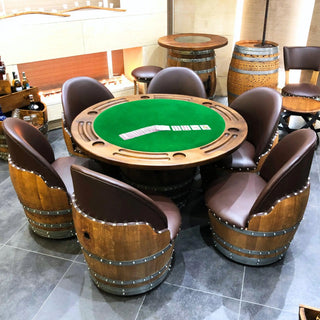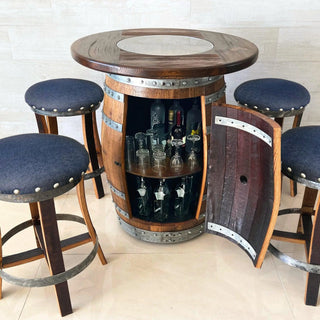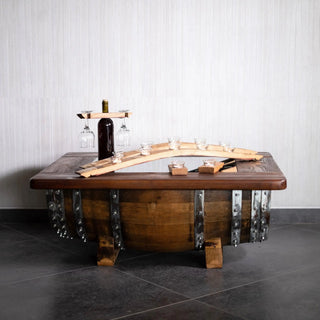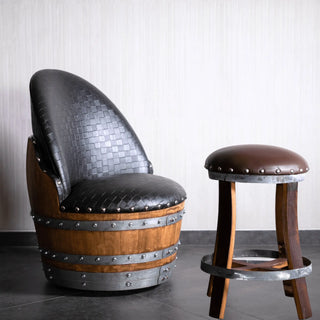Mixing Wood Finishes: How to Balance Barrel Tables with Other Furniture
There’s something magical about walking into a room that just feels right. The light hits the wood, the textures blend, and somehow, even though nothing perfectly matches… it all works. It feels layered, lived-in, and personal — not like a catalog page, but like a home.
That’s the beauty of mixing wood finishes — when you get it right, it looks effortless.
And if you’ve ever fallen for a barrel coffee table or end table (and honestly, who hasn’t?), you already know the challenge: how do you make this rugged, reclaimed piece play nicely with everything else in your home?
I remember the first time I brought home my Wine Barrel Coffee Table with a Glass Top. The oak was rich and full of character, the kind of wood that practically glows under sunlight. But when I set it down in my modern living room, surrounded by clean lines and cooler tones, I froze.
It was stunning — but it stuck out like an old soul in a room full of new money.
That’s when I learned one of the most satisfying lessons in interior design: when you balance your wood finishes instead of matching them, everything starts to sing together.
Start with a Hero — and Let It Lead the Story
Every room needs a main character — that one piece that defines the vibe and tells the story. For me, that’s always the barrel table.
These tables already come with personality baked in. They’ve lived a life before yours — holding wine, soaking in flavors, aging gracefully under time and pressure. So let that history take the lead.
If your barrel table has deep, aged tones and visible barrel hoops, build around that warmth. Use lighter or cooler woods for your other furniture so the oak stands out naturally. If your barrel table is a lighter reclaimed finish, balance it with darker accent pieces — a deep walnut shelf or black metal-framed chairs work beautifully.
The trick isn’t making everything match — it’s letting your favorite piece set the tone.
Think of it like composing music. Every note doesn’t sound the same — but when you choose the right key, it all harmonizes.
It’s Not Just About Color — It’s About Character
Most people think “wood tones” mean shades of brown — but that’s only part of the story. What really ties a space together is texture.
A reclaimed oak barrel table has texture you can feel — grooves, subtle cracks, soft edges, faint stains from its past life. It has warmth and imperfection. So if your other furniture is super smooth and modern, balance that by bringing in more natural elements.
Try pairing your barrel coffee table with a linen sofa, a woven rug, or a few ceramic vases. Add a leather ottoman or a matte metal floor lamp. The more tactile variety you introduce, the more natural it all feels.
I once mixed my reclaimed Barrel End Table with a high-gloss white console — sounds risky, right? But then I added a rattan basket and a soft wool throw, and suddenly, it wasn’t “contrast.” It was composition.
When textures complement each other, your space feels curated, not chaotic.
Contrast: The Secret Ingredient No One Talks About
If you’ve ever walked into a room where all the furniture is the same wood tone, you know the feeling — flat, heavy, and kind of... blah.
That’s because everything’s competing for attention. There’s no focal point, no balance.
Contrast changes that.
If your floors are dark, a light oak barrel coffee table will pop beautifully. If your table has deep reddish undertones, balance it with something matte black or cream nearby. And if your woods are all over the place? Relax — use a neutral rug to anchor everything together.
Contrast gives a space depth. It tells your eyes where to look. And when one of those focal points happens to be a reclaimed oak barrel that’s lived a former life in a Napa cellar or a Kentucky rickhouse — well, you’ve already won.
Repeat, Echo, Connect
Here’s one of my favorite design tricks: repetition.
When you repeat a tone, texture, or finish somewhere else in the room — even in a small way — it creates harmony.
If your barrel table has a golden oak finish, maybe hang a few barrel head wall art pieces or add a stave coat rack nearby. If it’s a darker whiskey oak, choose picture frames or lamp bases with similar tones.
These little echoes make the space feel unified without looking staged.
In my living room, I added a Wine Barrel Lazy Susan on my dining table and a small barrel stave candle holder on a shelf — and suddenly, my coffee table didn’t feel like an outlier anymore. It felt like part of the home’s DNA.
Let Metal Be the Mediator
Metal is magic when you’re mixing woods.
It’s the universal translator of materials — bridging the gap between rustic oak and polished walnut, between light ash and dark espresso.
And guess what? Your barrel furniture already gives you a head start. Those metal hoops around the oak staves aren’t just decorative — they’re design anchors.
Match your hardware and décor to those tones. If the hoops are blackened steel, use matte black curtain rods or lamp bases. If they’re brushed bronze, sprinkle a few brass accents around.
It’s subtle, but it makes a massive difference. The metal acts like punctuation in a sentence — separating thoughts, adding flow, and making sure every element has its moment.
Lighting: The Final Piece of the Puzzle
Even the most beautiful wood can fall flat under bad lighting.
Oak, especially reclaimed oak, looks best under warm light — something that highlights its grain, its patina, its golden undertones. Cool white light tends to wash it out.
If you can, use table lamps or pendant lights with warm bulbs (around 2700K). It gives your barrel tables that cozy glow that makes everything feel intentional — even if your furniture came from three different design eras.
And don’t underestimate natural light. The way sunlight dances on oak at 4 p.m.? That’s design in its purest form.
Forget “Matching.” Aim for Mood.
At the end of the day, your space doesn’t need to look like a showroom. It needs to feel like you.
Mixing wood finishes isn’t about creating symmetry — it’s about creating atmosphere. Your barrel table doesn’t have to blend in; it has to belong.
So trust your instincts. Let imperfection be part of the charm. Don’t panic if one chair is walnut and the other is pine — if the room feels balanced, it is balanced.
Because the best rooms are the ones that tell a story. And a handcrafted, reclaimed oak barrel table — with its curves, textures, and quiet history — will always be the best storyteller in the room.
Our Links
- Shop Oak Barrel Coffee & End Tables
- Explore Reclaimed Wine & Whiskey Barrel Furniture
- Discover Barrel Home Decor & Accessories
Other Resources to Explore
- Architectural Digest – The Art of Mixing Wood Finishes at Home
- Elle Decor – How to Blend Rustic and Modern Design Styles
- Dwell – Why Texture Matters More Than Color in Design
In the end, balance isn’t about matching every color. It’s about creating a feeling.
A room where light hits oak, shadows play on iron, and everything — somehow — just fits.
That’s what happens when you learn to mix wood finishes with confidence. Your space stops being a collection of furniture — and becomes a story.
And at the heart of it all? That reclaimed barrel table that started the conversation.
Disclaimer:
This article is for inspiration and general design guidance only. Every piece from Oak Wood Wine Barrels is handcrafted from authentic reclaimed oak barrels, meaning variations in tone, grain, and texture are completely natural — and part of each table’s charm. Always review product details and finishes before purchase. Over time, real oak develops new hues and character — a living record of the space it calls home.




